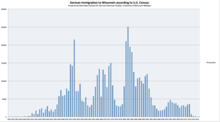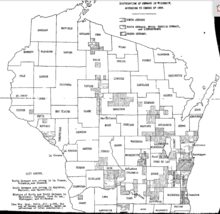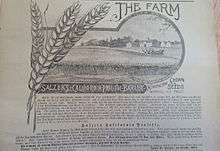Wisconsin German
The term Wisconsin German refers to both Wisconsin High German and to heritage dialects of German spoken in Wisconsin.[1]:5 By 1853 a third of Wisconsin's population was coming from German-speaking lands; by the end of the 19th century, Wisconsin's largest minority of non-English speakers were German speakers.[2]:37 Unlike other heritage languages, which tend to become moribund by the third generation, Wisconsin German speakers have maintained their heritage language(s) alongside English for multiple generations,[1]:5 from the 1840s to well until the mid-20th century. This is due in part to their immigration patterns: the German immigrants tended to settle within ethnically homogeneous (or similar) communities,[3][4] with similar linguistic, cultural, and geographic backgrounds.[1][4]:119–120 Additionally, the maintenance of the language was supported by German being taught and used in many local churches, schools, and the press.[3] While Wisconsin German retains many standard and/or dialectal features of German, it has not only incorporated some linguistic elements of English, but also developed unique and innovative (morphosyntactic,[1] syntactic,[5] lexical[6]) characteristics of its own. By the early mid-20th century, social, political and economic factors such as urbanization, contributed to a general shift from German to English.[4]
| Wisconsin German | |
|---|---|
Native speakers | 36,443 (2013) |
| Language codes | |
| ISO 639-3 | – |
| Languages | |
|---|---|
| English, Wisconsin High German, Low German, Kölsch, Swiss German, Luxembourgish |
History
By the mid-19th century, many German immigrants had settled in Wisconsin[3]:26 and by the latter half of the 1800s German speakers had chosen Wisconsin over other American states as their destination.[7]:45 This was partly because of the state's resources, available land, and the entrepreneurship of land agents,[8] but also because these immigrants were seeking new economic opportunities, and religious or political freedom.[9]
The Wisconsin city of Freistadt, for example, was founded by 300 German Lutherans from Pomerania, who were escaping Prussian religious reform and persecution.[9]:347–48 They called their colony Freistadt, or "free city", most likely to commemorate their newfound religious freedom in the Americas.[9]:348 Both their faith and maintenance of their East Pomeranian dialect were important to the Freistadters: although the city was founded in 1839, there were still East Pomeranian speakers in Freistadt well into the end of the 20th century.

Wisconsin High German and dialects

These German speakers were from many different regions and states, such as Mecklenburg-Schwerin, Pomerania, Posen, Rhineland, Westphalia, Switzerland,[10] Bavaria, Luxembourg, Baden, Saxony, Hesse, Württemberg, and Austria.[9] Each group brought its own dialect, which it continued to use in the home, community and even in local Wisconsin businesses.[3]:27–28
In addition, a form of Wisconsin High German, a koiné of Standard German with dialectal features,[1] was used parallel to the community's dialect, such as in churches, and elementary and secondary schools; this meant that many Wisconsinites were trilingual, speaking their heritage dialect, Wisconsin High German and English.[11] The extended multilingual contact over multiple generations of Wisconsin German heritage speakers, has resulted in the development of a language that not only contains features of their ancestral dialect, standard German and English, but also developed new linguistic features of its own.

Language maintenance
Schools
For the early German settlers, German, not English, was the predominant language used in schools in rural Wisconsin (Petty).[2]:42 Teachers were hired from Germany, German textbooks were at first imported, then later printed in the US. By 1854, the Wisconsin State Law declared that all major subjects were to be taught in English (Petty);[2]:42 however the state had little authority over local schools, which were locally governed and financed (Petty).[2]:42 Schools fully switched to English by the early 20th century, which partially contributed to the gradual decline of German heritage speakers.
Grammar
Previously, researchers have looked at heritage languages to study incomplete acquisition or L1 attrition (Polinsky, 1995; Sorace 2004; Montreal 2008), yet speakers of Wisconsin German do not fit into either of those categories.[1]:2 Modern Wisconsin Heritage German speakers have grown up speaking German in the home, and often only learned English upon entering school, around the age of 6.[1]:2 This means that their German, including grammatical features such as dative, would have already been acquired,[1][12] if it existed in the speakers' heritage language.
Morphosyntax
One difference between Wisconsin Heritage German and Standard German and its ancestral dialects are changes in its case marking system, such as the loss of the dative case.[1] In Germany, there exists variation among its different dialects: for instance, in the Rhenish Hesse region, one can still find a three-case marking system (nominative, accusative, dative); in the Eifel, a two-case system; and in the Low German dialectal regions, a single case system.[1] However, in Wisconsin German, while heritage speakers appear to no longer show use of the dative case, they have developed new morphosyntactic features. Across different dialects, heritage speakers have begun marking case in same or similar ways:[1]:6 in some cases, their Differential Object Marking (DOM) would align with Standard German morphology; in other cases, speakers appear to have restructured and reanalysed the DOM to create a new semantic-morphosyntactic system.[1]:6 For example, Yager et al. (2015) cite the following examples to illustrate this phenomenon:[1]:2
| Wisconsin Heritage German (WHG) | Standard German (SG) | ||||||
|---|---|---|---|---|---|---|---|
| Example 1: Standard-like dative | im | Boom | im | Baum | |||
| in the-Dative | tree | in the-Dative | tree | ||||
| Example 2: Accusative for SG dative | von ein | Dorf | von einem | Dorf | |||
| from a-Nominative/Acc | village | from a-Dative | village | ||||
| Example 3: Innovative marking | es war | in den | Haus | es war | im | Haus | |
| It was | in the-Accusative | house | It was | in the-Dative | house | ||
Example 1 shows that Wisconsin German still contains some instances of dative.[1]
In Example 2 a neuter indefinite article has been selected; however it is unclear if it is in the nominative or accusative case. This is a departure from Standard German, where a dative neuter article ("einem") would be used. This is an example of a restructuring of the DOM in Wisconsin German.
Example 3 illustrates innovative case marking: instead of a dative neuter definite article ("dem"), a distinctly masculine accusative definite article has been selected.[1] Heritage speakers could have selected a nominative ("das"), accusative ("das") or dative article ("dem"), but instead not only select an accusative marking but also a masculine article.
This pattern has appeared not only with a single group of heritage speakers, but rather can be found in speakers of different German dialects (such as the Rhenish Hesse, Eifel, and Low German dialects).[1]
Documentation
One of the first recordings of Wisconsin German dialects was made in the 1940s by Lester "Smoky" Seifert, a professor of German at the University of Wisconsin–Madison. Seifert, an East Low German speaker, recorded over 100 written interviews with Wisconsin German speakers, in which he included both linguistic and cultural questions.[7]:55
References
- Yager, Lisa; Hellmold, Nora; Joo, Hyoun-A.; Putnam, Michael T.; Rossi, Eleonora; Stafford, Catherine; Salmons, Joseph (2015-01-01). "New Structural Patterns in Moribund Grammar: Case Marking in Heritage German". Frontiers in Psychology. 6: 1716. doi:10.3389/fpsyg.2015.01716. PMC 4653281. PMID 26635649.
- Petty, Antje (2013). "Immigrant Languages and Education: Wisconsin German Schools". In Purnell, Thomas; Raimy, Eric; Salmons, Joseph (eds.). Wisconsin Talk. Madison, Wisconsin: The University of Wisconsin Press. pp. 26–36. ISBN 978-0-299-29334-5.
- Lucht, Felecia (2013). "Older Immigrant Languages". In Purnell, Thomas; Raimy, Eric; Salmons, Joseph (eds.). Wisconsin Talk. Madison, Wisconsin: The University of Wisconsin Press. pp. 26–36. ISBN 978-0-299-29334-5.
- Frey, Benjamin (2013). "Towards a General Theory of Language Shift: A Case Study in Wisconsin German and North Carolina Cherokee". Ph.D. Dissertation, University of Wisconsin-Madison. ProQuest 1428389176.
- Bousquette, Joshua; Frey, Benjamin; Henry, Nick; Nützel, Daniel; Putnam, Michael (2013). "How deep is your syntax? Heritage language filler-gap dependencies". University of Pennsylvania Working Papers in Linguistics. 19.
- Goss, Emily; Salmons, Joseph (2000). "The evolution of a Bilingual Discourse Marking System: Modal particles and English markers in German-American dialects". The International Journal of Bilingualism.
- Eichoff, Jürgen (1971). The German Language in America: A Symposium. Austin: University of Texas Press. pp. 43–57.
- Johannes Strohschank and William G. Thiel. The Wisconsin Office of Emigration 1852-1855 and Its Impact on German Immigration to the State. Madison: Max Kade Institute, 2006.
- Everest Levi, Kate (1898). "Geographical Origin of German Immigration to Wisconsin". In Thwaites, Reuben Gold (ed.). Collections of the State Historical Society of Wisconsin. XIV. Madison, Wis.: Democrat Printing Company. pp. 341–393.
- Lewis, Brian A. (1973-01-01). "Swiss German in Wisconsin: The Impact of English". American Speech. 48 (3/4): 211–228. doi:10.2307/3087829. JSTOR 3087829.
- Center for the Study of Upper Midwestern Cultures. "Wisconsin High German". American Languages: Our Nation's Many Voices Online.
- Eisenbeiss, Sonja; Bartke, S.; Clahsen, H. (2009). "Structural and lexical case in child German: evidence from language-impaired and typically developing children". Language Acquisition. 13: 3–32. doi:10.1207/s15327817la1301_2.
Bibliography
- Bungert, Heike, Cora Lee Kluge, and Robert C. Ostergren (eds.). Wisconsin German Land and Life. Madison: Max Kade Institute for German-American Studies, 2006.
- Eichoff, Jurgen (1971). The German Language in America: A Symposium. Austin: University of Texas Press. pp. 43–57.
- Everest Levi, Kate (1898). "Geographical Origin of German Immigration to Wisconsin". In Thwaites, Reuben Gold. Collections of the State Historical Society of Wisconsin XIV. Madison, WI: Democrat Printing Company. pp. 341–393
- Lucht, Felecia (2013). "Older Immigrant Languages". In Purnell, Thomas; Raimy, Eric; Salmons, Joseph. Wisconsin Talk: Linguistic Diversity in the Badger State. Madison, Wisconsin: The University of Wisconsin Press. pp. 26–36. ISBN 978-0-299-29334-5.
- "Wisconsin High German". American Languages: Our Nations Many Voices Online.
External links
- "American Languages: One Nation, many Voices. German Dialects"
- Lester "Smoky" Seifert: transcripts and sound files of Wisconsin German interviews; site also includes autobiographical information about Lester "Smoky" Seifert, a University of Wisconsin-Madison professor (1940s) and pioneer in conducting fieldwork on Wisconsin German languages.
- Pommerscher Verein: A webpage of a prominent Wisconsin Pomeranian club. Includes brief history of the community and history of Pomeranians in Freistadt, Wisconsin.
- Max Kade Institute Archives: Scans of primary sources, such as German cookbooks, letters, newsletters printed in the US. Includes an interesting article (1891) "Die Schönheit der deutsch-amerikanischen Sprache". (Beauty of the German-American language)
- Wisconsin Low German: limited information, although includes several audio samples of East Pomeranian (Low German).